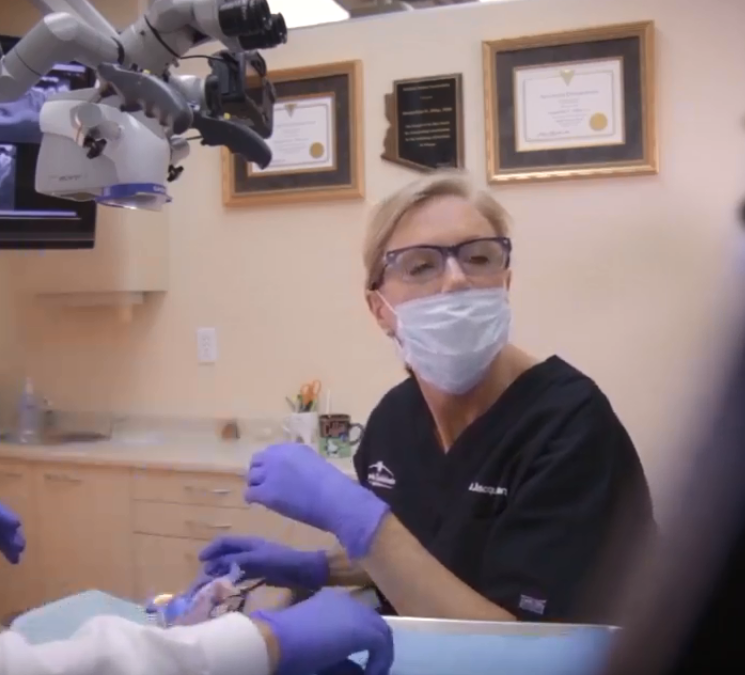
by Dr. Jacqueline S. Allen | Apr 22, 2020 | Blog, Dental Implants, Phoenix Endodontic Group
When considering dental implants, you can expect your endodontist to allow three to six months for healing, after placing the implant and before placing a permanent restoration on top of the tooth. The implant and its crown will take the place of your natural tooth. There are several factors influencing how quickly a dental implant will heal, and their interplay determines how quickly you can expect the process to be finished.

What Influences The Dental Implant Healing Process?
-
Bone loss in the area of the jaw receiving the implant. If the dental implant is replacing a missing tooth, or if the natural tooth being extracted was damaged, the bone density at the implant site may not be sufficient to allow the metal implant post and the jawbone to grow together. A bone graft may be required to prepare the site before the implant can be placed. In this case, the implant may require up to six months of healing before a permanent restoration can be placed on top of it.
-
Location of the natural tooth being replaced by the dental implant. A dental implant intended to replace a front tooth with its small roots will generally take less time to heal than back teeth or teeth with longer roots.
-
The presence of gum disease or infection in the natural tooth to be replaced. Active infection in a tooth or gum disease near the implant site will require a longer healing period because the infection or disease must first be controlled and healed.
Often, a temporary restoration such as a crown can be placed on a dental implant while it is healing. This is an option when it will not endanger the integration process, which will be evaluated by your endodontist.
“Two of the most important phases of the dental implant process are the diagnostic and planning stages,” says Dr. Jacqueline S. Allen, who practices with the Phoenix Endodontic Group. “Careful examination of the current state of a patient’s teeth and gums can help us provide a more accurate healing timeline.”

by Dr. Jacqueline S. Allen | Mar 31, 2020 | Blog, Endodontics, Endodontist, Root Canal
A damaged or infected tooth needs to be assessed by a dental professional as soon as possible. Endodontists are dental professionals who specialize in saving natural teeth through root canal treatments and other procedures. However, even with today’s technology, the most skilled of endodontists cannot save every tooth. There are times when the best course of action is simply to have a failing tooth removed.

Situations In Which A Root Canal Is Better
-
The symptoms of a damaged tooth are recognized early. If you notice severe pain while chewing, a pimple on your gum, tender gums, lasting sensitivity to hot or cold foods, or certain other symptoms that indicate your tooth’s pulp is infected, schedule an appointment with your dentist or endodontist immediately. The sooner your tooth can be examined, the more likely it is your natural tooth can be saved.
-
Your tooth’s structure is still strong. Root canals remove the nerve pulp inside your tooth’s roots and replace them with a biocompatible material. A crown is placed over the treated tooth to provide it with additional support. This treatment can be effective long-term 95 percent of the time, but if your tooth’s structure has been eroded by decay or injury, it is much less likely to be successful.
-
Your tooth roots are relatively easy to clean. The success of a root canal hinges largely on how well your endodontist can remove infection from your tooth roots before sealing the canals. If you have long or unusually shaped root canals, this may be difficult.
When Extraction Is Better
Your dental professional may recommend a tooth extraction if any of the following are true:
-
The tooth is badly decayed
-
The tooth has suffered a severe fracture
-
The tooth isn’t supported well by the surrounding gum tissue due to periodontal disease
-
The tooth has received a root canal treatment or retreatment and is still failing
“Your endodontist can determine whether an extraction and tooth replacement or a root canal is the better option for your natural tooth,” says Dr. Allen, who practices with the Phoenix Endodontic Group. “Both treatments are effective in restoring your mouth’s function and appearance.”

by Dr. Jacqueline S. Allen | Feb 20, 2020 | Blog, Dental Implants, Phoenix Endodontic Group
Sometimes to get the right answer about your oral health, you have to ask the right question. If your question is “Is it possible to perform a dental implant in one day?” the answer is a definite yes. However, if your question is “Can I have a dental implant done in one day?” the answer is a solid maybe.
Over the past few decades, dental implants – whether to replace one tooth or an entire arch of teeth – have become a popular alternative to dentures. However, a dental implant is a complex procedure. Your dentist or oral surgeon will need to conduct a thorough examination of the state of your teeth and gums to determine if a single-day implant would be successful for you in the long term.

Factors That Determine Whether A Single-Day Implant Process Is Possible
- How many natural teeth need to be replaced. The greater the number of failing or missing natural teeth, the more pre-treatment assessment planning it will take to ensure the success of a single-day implant. If failing teeth are to be extracted at the same time as the dental implants are placed, this will also impact how your dental team approaches the procedure.
- The bone density of your jaw. Dental implants are secured by metal posts or fixtures that are placed in your jawbone. If you need numerous implant posts to support the crowns that will replace your lost teeth above the gumline, you may need to undergo bone grafts to increase bone density.
- Your gums and remaining teeth must be healthy. For a single-day dental implant procedure to succeed, your mouth should be free of gum disease and infected or damaged teeth.
- You can commit to a significant healing period after your single-day implant is delivered. After a dental implant procedure, you must carefully watch what you consume for six to eight weeks, while your implants integrate into your jaw.
“Advancements in both technology and dental implant techniques allow us to place dental implants faster and with far less discomfort than ever before,” says Dr. Jacqueline S. Allen, an endodontist in practice at the Phoenix Endodontic Group. “Our staff can evaluate the condition of your teeth and gums and provide an accurate estimate of how long your dental implant may take to complete.”

by Dr. Jacqueline S. Allen | Feb 10, 2020 | Blog, Endodontist, Phoenix Endodontic Group, Root Canal
Dr. Jacqueline Allen is qualified to utilize the minimally invasive Waterlase™ to treat dental conditions with less discomfort to the patient and in some cases use less to no anesthetic. Dr. Allen completed the advanced endodontics continuing education with Dr. William Chen, at the Chen Laser Institute. The course provided in depth training for laser-assisted endodontics to help meet many of the toughest clinical challenges and techniques on single and multiple root canal therapy using the laser, among other advanced endodontic techniques.

Waterlase Dentistry uses laser energy and a gentle spray of water to perform a wide range of dental procedures — without the heat, vibration, and pressure associated with the dental drill, and in many cases without the blood of a traditional scalpel. Dr. Jacqueline Allen offers Waterlase™ treatments to patients who would prefer to receive the latest laser treatment as an alternative to more traditional oral surgery methods.
Those who suffer from anxiety due to past dental experiences or fear of needles are more likely to feel calm and relaxed when receiving treatment with the gentle Waterlase™ system, with many patients reporting no or less pain, and many cases of fewer shots. Laser-based dental care has also been shown to cause less swelling and bleeding at the treatment site. Patients have been shown to recover more quickly, with faster healing, with the use of Waterlase, making dental care a much more convenient and pleasant experience.
Patients who are interested in making an appointment with an endodontist in Phoenix, AZ., who utilizes laser technology to treat oral problems are invited to schedule an appointment with Dr. Allen’s office at their convenience. To learn more about this cutting-edge dentistry technology visit biolase.com.

by Dr. Jacqueline S. Allen | Dec 22, 2019 | Blog, Dental Implants, Dentistry
While it’s often possible to save an injured or infected tooth, sometimes extraction is the best option. In those cases, it is important to replace the tooth as soon as possible with a dental implant. If gaps from extracted teeth are left as is, the interaction between the remaining teeth, the jawbone, and gums is disrupted. The jaw can lose bone density, causing it to shrink. Gums can pull away from the remaining teeth, and the teeth may loosen and move into the gap left by the extraction.

How Soon Can I Have A Dental Implant After A Tooth Is Removed?
The answer to how long you will have to wait for a dental implant after a tooth extraction – and how long the implant process will take to complete – depends largely on where the extracted tooth was located and the general state of your oral health.
Front teeth that had no infection at the time of extraction and had small roots (such as an incisor or canine) may be able to receive the dental implant the day that the tooth is removed. A crown can be placed on top of the implant in a few months, after the implant has integrated into the jaw bone. If the tooth in question was a back tooth, or had longer roots, it may be necessary to wait two or three months after extraction to place the dental implant. If the extracted tooth was infected, this can delay the placement of the dental implant even longer, in order to allow the site of the extraction to heal fully.
Bone loss in the jaw can cause a cascade of problems after a tooth is extracted, and if a patient’s bone density at the site of the extraction is low enough, they will likely require a bone graft. Sometimes the amount of bone to be grafted is significant enough that it will require several months for the graft to be integrated into the jaw bone. At other times, the amount to be grafted is small enough that it can be done at the same time the implant is placed.
“When preparing to provide a dental implant, it is important not to rush to place the implant,” says Dr. Jacqueline S. Allen, an endodontist practicing with the Phoenix Endodontic Group. “Our dental specialists can conduct a thorough examination and discuss the factors that will influence the timeline of your dental implant process.”









